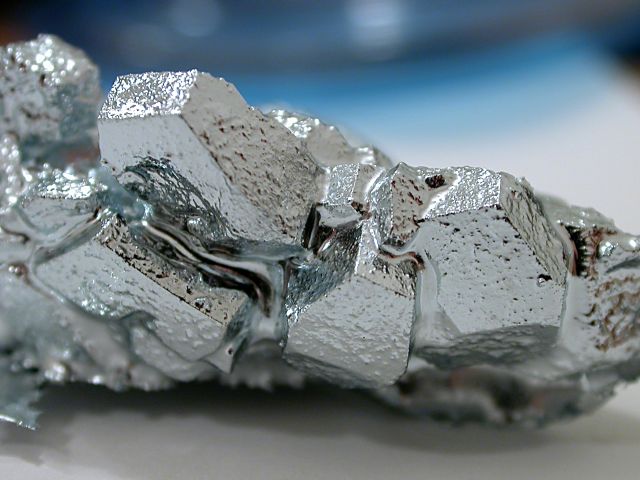Gallium

Gallium
Image by foobar - source Wikpedia -
This image file is licensed under the CC 3.0.
Gallium - Overview
Gallium is a very interesting and unusual metal. It was discovered in 1875 and is not found in its pure, elemental state in nature. Its most famous characteristic is that it has an unusually low melting point (29.8ºC) and so would melt if you held it in your hand. Other metals with low melting points are caesium (28.44ºC) , rubidium (39.31ºC), francium (exceedingly rare - estimated 27ºC) and mercury (-38.83ºC). Unlike mercury, gallium wets glass and skin. [1]
Gallium is also one of only a few materials that expands upon solidifying - others being silicon, germanium, bismuth, antimony and water. [1]
Gallium Resources and Production
Gallium is not found uncombined in nature. There are a small amount of minerals with high gallium content, such as gallite (CuGaS2 ), however this does not occur insignificant enough quantities for commercial-scale production. Gallium is extracted commercially from aluminium and zinc ores such as sphalerite, in which it occurs as a trace mineral. It is not currently economically viable to extract it from other sources. [1] Gallium is produced in China, Germany, Kazakhstan, Ukraine, Hungary, Japan, Russia, and Slovakia. Gallium is also recycled from scrap in Germany, Japan, the United Kingdom, and the USA. [2]
It is estimated that global gallium production was 184 tonnes in 2007, with almost 50% coming from recycling. [1]
Gallium Uses
The vast majority of gallium used is in the manufacture of electronic components. Gallium is used in high-brightness LEDs, LCD screens, mobile phones and high-speed wireless. [2] Gallium has been used in LEDs since the 1960s [4] and is featured in several of the LED colors. [5]
In 2009, 67% of the gallium used went towards integrated circuits. Optoelectronic devices - including solar cells and LEDs made up 31% of demand. The remaining 2% went towards research, alloys, medical and other applications. [2]
Gallium arsenide is one of the materials that can be used to make solar panels. In recent times, gallium has been a component in record-breaking solar technologies: In 2009, over 15% efficiency (conversion of sunlight into electricity) was achieved with a thin-film CIGS (copper indium gallium selenium) solar cell. In this application, gallium competes with silicon and other materials used to make solar cells.[2]
Gallium is used in alloys to lower melting point - and is added to some solders for this reason. An alloy of gallium, indium and tin is used in medical thermometers as a substitute for mercury. These alloys are currently undergoing research for possible use in computer cooling. [1] Another gallium alloy, under investigation for potential use in hydrogen energy technology, is gallium-aluminium - which reacts with water to generate hydrogen.
Gallium is highly resistant to heat and solar radiation damage - meaning that it is also used for space technology and solar collectors / concentrators. It makes a brilliant, highly reflective mirror surface. [3]
Gallium is considered to be one of the major critical metals. Its unique properties mean that it is the best material currently possible for several applications - and there are challenges in its production - chiefly that it occurs in low concentration.
Gallium Facts
| Name | Gallium |
| Symbol | Ga |
| Atomic Number | 31 |
| Melting point (Celsius) | 29.7646ºC |
| Density | 5.904 g/cc |
| Hardness (Moh) | 1.5 |
| Resistivity (nanoOhms / meter at 20ºCelsius) | 270 |
Gallium References:
[1] http://en.wikipedia.org/wiki/Gallium
[2] http://minerals.usgs.gov/minerals/pubs/commodity/gallium/mcs-2010-galli.pdf
[3] http://www.azooptics.com/Details.asp?ArticleID=147
[4] http://minerals.usgs.gov/minerals/pubs/commodity/gallium/460798.pdf
[5] http://en.wikipedia.org/wiki/Led#Colors_and_materials

This website is not investment advice or a recommendation to buy or sell.


